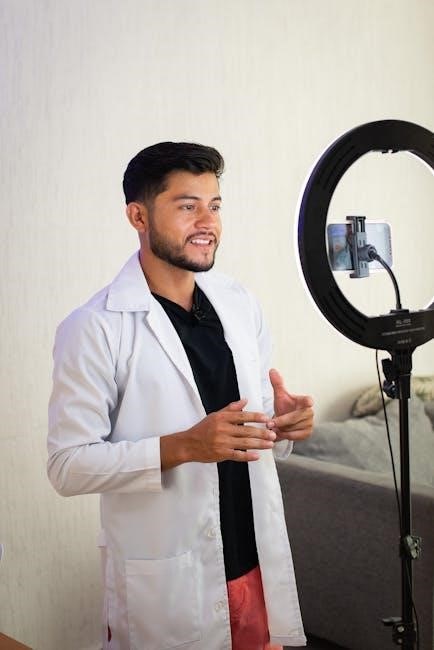Mastering question formation is essential for effective Spanish communication. This interactive tutorial guides you through the basics of creating questions, enhancing your conversational skills with engaging exercises and practical examples. Get ready to transform your declarative sentences into engaging questions with ease!
Importance of Mastering Question Formation
Mastering question formation in Spanish is crucial for effective communication and building strong conversational skills. By learning to ask questions, you can gather information, clarify doubts, and engage in meaningful interactions. Understanding how to form questions helps you navigate real-life situations, from asking for directions to participating in discussions. It also enhances your ability to comprehend and use Spanish grammar correctly. Interactive tutorials and exercises provide practical ways to practice question formation, making learning engaging and accessible. This skill is foundational for advancing your Spanish proficiency and confidently expressing yourself in various contexts.

Methods of Forming Questions
Spanish questions can be formed through three main methods: changing intonation, inverted word order, and using question words. These methods help create clear and effective interrogative sentences.
Changing Intonation
In Spanish, one of the simplest ways to form a question is by changing the intonation of a statement. This involves raising the pitch of your voice at the end of a sentence, similar to how questions are formed in many other languages. For example, the statement “usted trabaja los domingos” (you work on Sundays) becomes a question by simply raising the pitch: “¿Usted trabaja los domingos?” This method is straightforward and requires no changes to the word order or structure of the sentence. It is a common technique used in both formal and informal settings. Mastering this intonation is key to sounding natural when asking questions in Spanish. This approach is especially useful for yes/no questions and is widely understood in most Spanish-speaking contexts.
Inverted Word Order
In Spanish, another common method for forming questions is by using inverted word order. This involves placing the verb before the subject, which is the opposite of the typical sentence structure. For example, the statement “Tú comes una manzana” (You eat an apple) becomes the question “¿Comes una manzana tú?” This inversion is a key feature of question formation in Spanish. It applies to both formal and informal sentences and is essential for constructing clear and grammatically correct questions. By mastering this technique, learners can effectively transform declarative sentences into interrogative ones, enhancing their ability to communicate in Spanish. Understanding inverted word order is a fundamental step in developing conversational proficiency.
Using Question Words
Using question words is a fundamental method for forming open questions in Spanish. Common question words include qué (what), dónde (where), cuándo (when), quién (who), and cómo (how). These words are used to seek specific information and are placed at the beginning of the sentence. For example, “¿Dónde vives?” (Where do you live?) or “¿Cuántos años tienes?” (How old are you?). In Spanish, question words are often accompanied by inverted word order, making them essential for constructing clear and grammatically correct questions. Mastering these words is crucial for effective communication, as they allow learners to ask detailed and specific questions in various contexts. This method is particularly useful for open questions that require more than a simple “yes” or “no” answer.

Types of Questions
Spanish questions are categorized into yes/no questions and open questions. Yes/no questions seek confirmation or denial, while open questions require detailed responses and often use question words like qué or dónde.
Yes/No Questions
In Spanish, yes/no questions are formed by changing intonation or using inverted word order. For example, “Tú trabajas los domingos” becomes “¿Trabajas los domingos?” by raising the pitch at the end. This method is straightforward and widely used in both formal and informal contexts. Additionally, inverted word order can be applied, such as “¿Viven ustedes aquí?” instead of “Ustedes viven aquí”. These questions seek a simple affirmation or negation, making them essential for basic communication. They are often used in everyday conversations to confirm information or clarify details. Mastering yes/no questions is a foundational step in developing conversational fluency in Spanish. By practicing these structures, learners can enhance their ability to engage in simple yet effective interactions.
Open Questions
Open questions in Spanish require more detailed responses and often begin with question words such as qué (what), dónde (where), cuándo (when), quién (who), cuál (which), or cómo (how). For example, “¿Cómo te llamas?” (What is your name?) or “¿Dónde vives?” (Where do you live?). These questions encourage the respondent to provide specific information, making them essential for deeper conversations. Open questions are formed using standard word order but must include a question word at the beginning. Intonation alone is not sufficient for open questions; the question word is necessary for clarity. Practicing open questions helps learners gather detailed information and enhance their conversational skills in Spanish. Mastering these structures is crucial for effective communication in various situations, from casual chats to formal interviews.

Formal and Informal Forms
In Spanish, questions can be formal or informal, depending on the context. Formal questions use usted, while informal questions use tú. Understanding these forms is crucial for clear communication in different social settings.
Informal (Tú)
In informal Spanish, questions are formed using the pronoun tú. This is commonly used among friends, family, or when speaking to someone your age or in a casual setting. For example, ¿Hablas inglés? (Do you speak English?) is a simple question using tú. To form questions, you can either change the intonation of a statement or invert the word order, such as ¿Tú vas al cine? (Are you going to the movies?). The informal form is essential for everyday conversations and building rapport in relaxed environments. Mastering tú questions helps learners communicate naturally in Spanish-speaking settings. Understanding the structure and usage of informal questions is a key step in developing fluency;
Formal (Usted)
In Spanish, the formal pronoun usted is used to address someone with respect, such as older individuals, strangers, or people in professional settings. When forming questions with usted, the structure is slightly different from the informal tú. For example, ¿Habla usted inglés? (Do you speak English?) is a formal question. Similarly, ¿Usted va al cine? (Are you going to the movies?) uses the formal form. The verb conjugation for usted in the present tense is the same as the third person singular (he/she/it), making it easier to remember. Mastering formal questions is essential for professional and respectful communication in Spanish. Understanding the proper use of usted helps learners navigate formal interactions smoothly and appropriately.

Negative Questions
Negative questions in Spanish are formed by adding no before the verb and using question words like ¿No..;?. For example, ¿No comes? (Aren’t you eating?) demonstrates this structure clearly.
Forming Negative Questions
In Spanish, negative questions are formed by adding no before the verb and using question words like ¿No…?. For example, ¿No comes? (Aren’t you eating?) or ¿No estás estudiando? (Aren’t you studying?). This structure inverts the typical affirmative sentence structure and adds negation. Negative questions are used to confirm or deny the opposite of what is expected. They often begin with no and end with a question mark. Practice exercises, such as transforming affirmative sentences into negative questions, help reinforce this concept. Interactive tutorials provide engaging ways to master negative question formation through quizzes and real-life examples. This skill enhances your ability to communicate effectively in Spanish, both in writing and conversation.

Verb Conjugation in Questions
In questions, verbs are conjugated similarly to statements but without the subject. For example, ¿Hablas inglés? (Do you speak English?) uses the infinitive form hablar without the subject pronoun.
Present Tense
In Spanish, forming questions in the present tense involves conjugating verbs differently than in statements. For regular verbs, the endings change to reflect the subject, but in questions, the conjugation remains similar to the statement form. For example, ¿Hablas inglés? (Do you speak English?) uses the same conjugation as Hablas inglés (You speak English).
- Regular verbs in -ar, -er, and -ir follow the same conjugation patterns in questions as in statements.
- Irregular verbs, such as tener (to have) and venir (to come), must be memorized, as their conjugations do not follow predictable patterns.
Practicing verb conjugation in questions is crucial for mastering Spanish conversation. Use online resources and exercises to reinforce your understanding of present tense question formation.
Question Words with Verbs
Question words in Spanish, such as ¿qué? (what?), ¿dónde? (where?), and ¿quién? (who?), are used to form open questions. These words are placed at the beginning of the sentence and require the verb to be conjugated appropriately. For example, ¿Qué comes? (What are you eating?) uses the present tense verb comes (you eat). Similarly, ¿Dónde vives? (Where do you live?) uses vives (you live).
- Question words like ¿por qué? (why?) and ¿cómo? (how?) also require proper verb conjugation.
- Practice pairing question words with verbs in different tenses to improve your skills.
Mastering question words with verbs is key to forming clear and effective questions in Spanish.

Using Ser and Estar in Questions
Ser and estar are essential for asking about states in Spanish. Use ser for permanent traits (e.g., ¿Quién eres?) and estar for temporary conditions (e.g., ¿Cómo estás?).
Permanent State (Ser)
In Spanish, the verb ser is used to ask about permanent or inherent qualities of a person, place, or thing. For example, questions like ¿Quién eres? (Who are you?) or ¿De dónde eres? (Where are you from?) use ser to inquire about identity or origin. These questions seek information about permanent traits, such as nationality, profession, or physical characteristics. When forming questions with ser, the structure remains straightforward, as ser does not change to match the subject in questions. For instance, ¿Cuál es tu nombre? (What is your name?) or ¿Cuáles son tus hobbies? (What are your hobbies?) demonstrate how ser is used to ask about unchanging aspects of a person. Mastering the use of ser in questions is key to effective communication in Spanish.

Temporary State (Estar)
In Spanish, the verb estar is used to ask about temporary or changing conditions, emotions, or locations. For example, questions like ¿Dónde estás? (Where are you?) or ¿Cómo estás? (How are you?) use estar to inquire about someone’s current state or location. These questions focus on situations that are subject to change, such as feelings, physical conditions, or temporary positions. When forming questions with estar, the structure remains consistent, as it does not change to match the subject. For instance, ¿Qué está pasando? (What’s happening?) or ¿Dónde está el baño? (Where is the bathroom?) demonstrate how estar is used to ask about temporary or situational aspects. Understanding the difference between ser and estar in questions is crucial for clear and accurate communication in Spanish.

Practicing Question Formation
Interactive exercises and quizzes help learners practice forming questions in Spanish. Transform declarative sentences into questions using inversion, intonation, and question words like ¿Dónde? and ¿Qué?.
Exercises
Engage with interactive exercises designed to reinforce question formation skills. Transform statements into questions using inversion and question words. For example, convert “Usted trabaja los domingos” into “¿Trabaja usted los domingos?” Practice forming negative questions like “Susan is not…” into “Isn’t Susan…?” Use flashcards to memorize key terms and structures, such as “¿Cuántos años tienes?” and “¿Dónde vives?” Interactive quizzes provide immediate feedback, ensuring mastery of both formal and informal question forms. These exercises cover various tenses, including present, preterite, and imperfect, helping you build a strong foundation in Spanish question formation. Regular practice with these activities will enhance your ability to communicate effectively in Spanish.

Applying to Different Tenses
Master forming questions in various tenses, such as present, preterite, and imperfect. Learn how to adapt verb conjugation and word order for each tense, ensuring grammatical accuracy. Practice exercises provided.
Preterite
Forming questions in the preterite tense involves using the correct verb conjugation and word order. For example, ¿Comiste una manzana? (Did you eat an apple?) demonstrates the preterite form of comer. Similarly, ¿Vino Juan? (Did John come?) uses the preterite of venir. Inverted word order is applied, placing the subject at the end. Practice exercises, such as those in interactive tutorials, help reinforce these structures. Tools like Kahoot and Quizlet offer engaging ways to test your understanding. Mastering preterite questions enhances your ability to discuss past events in Spanish. Regular practice with sample sentences and quizzes ensures fluency and accuracy in using this tense effectively in conversations.
Imperfect
Forming questions in the imperfect tense involves using the correct verb conjugation and structure to inquire about ongoing or repeated actions in the past. For example, ¿Estudiabas español? (Were you studying Spanish?) uses the imperfect form of estudiar. Similarly, ¿Vivia ella en Madrid? (Did she live in Madrid?) employs the imperfect of vivir. Inverted word order is applied, placing the subject at the end. Interactive tutorials often include exercises like matching games or fill-in-the-blank activities to practice these structures. Tools like Kahoot and Quizlet provide engaging ways to test your understanding. Regular practice with sample sentences and quizzes helps reinforce the use of imperfect questions, enabling learners to discuss past habits and routines with confidence and clarity in Spanish.
Mastering question formation in Spanish is a fundamental step in becoming proficient in the language. Through this interactive tutorial, you’ve learned essential techniques such as changing intonation, inverting word order, and using question words. Practice is key to reinforcing these concepts, and tools like Kahoot, Quizlet, and interactive exercises provide engaging ways to test your skills. By understanding how to form questions in different tenses, including the present, preterite, and imperfect, you’ve built a solid foundation for effective communication. Remember, consistent practice and real-world application will help you ask questions with confidence and clarity, enhancing your ability to converse in Spanish. Keep exploring and refining your skills—¡buena suerte en tu aprendizaje del español!
